Introduction
Here are some examples of exercises for you to try. The exercises may be suggested for a condition or for rehabilitation. Start each exercise slowly. Ease off the exercises if you start to have pain.
You will be told when to start these exercises and which ones will work best for you.
How to do the exercises
Wrist extensor stretch (fingers straight or fist)
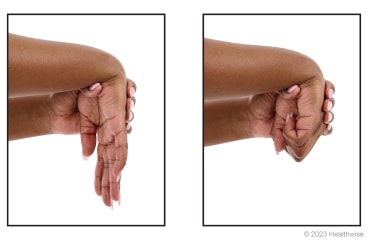
- Extend the arm with the affected wrist in front of you and point your fingers toward the floor.
- With your other hand, gently bend your wrist farther until you feel a mild to moderate stretch in your forearm.
- Hold the stretch for at least 15 to 30 seconds.
- Repeat 2 to 4 times.
- It's a good idea to repeat these steps with your other wrist.
When you can do this stretch with ease and no pain, try the exercise with your hand in a fist instead of with your fingers pointing down.
Forearm extensor stretch
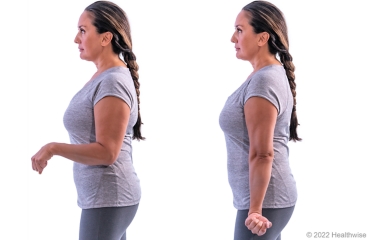
- Hold your affected elbow at your side, bent at about 90 degrees. Make a fist with your palm facing down and bend your wrist down.
- Keeping your wrist bent, slowly straighten your elbow so your arm is down at your side. Then twist your fist out so your palm is facing out to the side and you feel a stretch.
- Hold for at least 15 to 30 seconds.
- Repeat 2 to 4 times.
- It's a good idea to repeat these steps with your other arm.
Wrist flexor stretch
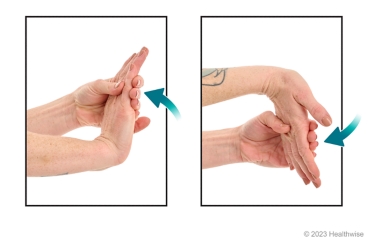
- Extend your affected arm in front of you with your palm facing down.
- Bend back your wrist on your affected arm, pointing your fingers up.
- With your other hand, gently bend your wrist farther until you feel a mild to medium stretch in your forearm.
- Hold for at least 15 to 30 seconds.
- Repeat 2 to 4 times.
- Repeat steps 1 through 5. But this time extend your affected arm in front of you with your palm facing up. Then bend back your wrist, pointing your fingers down.
- It's a good idea to repeat these steps with your other arm.
Resisted wrist flexion (weight)
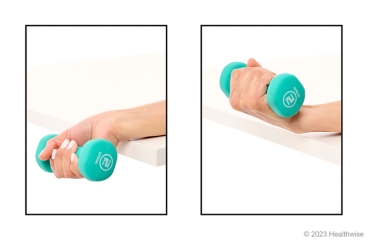
- Place your affected forearm on a table with your hand hanging over the edge of the table, palm up.
- Place a 1- to 2-pound weight in your hand. This may be a dumbbell, a can of food, or a filled water bottle.
- Slowly raise and lower the weight while keeping your forearm on the table and your palm facing up.
- Repeat 8 to 12 times.
- It's a good idea to repeat these steps with your other arm.
Resisted wrist extension (weight)
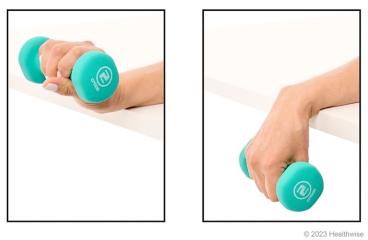
- Place your affected forearm on a table with your hand hanging over the edge of the table, palm down.
- Place a 1- to 2-pound weight in your hand. This may be a dumbbell, a can of food, or a filled water bottle.
- Slowly raise and lower the weight while keeping your forearm on the table and your palm facing down.
- Repeat 8 to 12 times.
- It's a good idea to repeat these steps with your other arm.
Resisted wrist extension (exercise band)
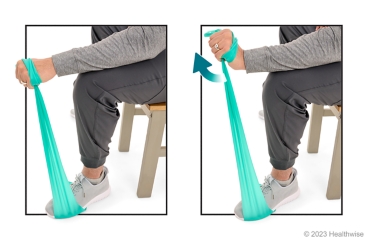
- Sit leaning forward with your legs slightly apart. Then place your affected forearm on your thigh with your hand and wrist in front of your knee.
- Grasp one end of an exercise band with your palm down. Step on the other end.
- Slowly bend your wrist upward for a count of 2. Then lower your wrist slowly to a count of 5.
- Repeat 8 to 12 times.
- It's a good idea to repeat these steps with your other arm.
Resisted wrist flexion (exercise band)
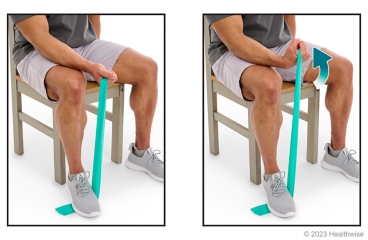
- Sit leaning forward with your legs slightly apart. Then place your affected forearm on your thigh with your hand and wrist in front of your knee.
- Grasp one end of an exercise band with your palm up. Step on the other end.
- Slowly bend your wrist upward for a count of 2. Then lower your wrist slowly to a count of 5.
- Repeat 8 to 12 times.
- It's a good idea to repeat these steps with your other arm.
Neck stretch to the side (upper trap stretch)
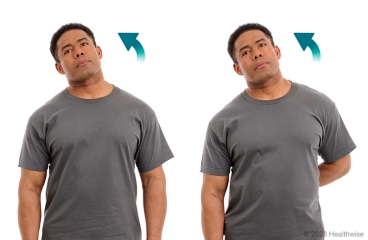
- Sit in a firm chair, or stand up straight. Keep your shoulder down as you lean away from it. To help you remember to do this, start by relaxing your shoulders and lightly holding on to your thighs or your chair.
- Look straight ahead. Tilt your head toward one shoulder and hold for 15 to 30 seconds. Relax and let the weight of your head stretch your muscles.
- Slowly return your head to the starting position.
- Repeat 2 to 4 times toward each shoulder.
If you would like a little added stretch, place your arm behind your back. Use the arm opposite of the direction you are tilting your head. For example, if you are tilting your head to the left, place your right arm behind your back.
You can also add more stretch by using one hand to pull your head toward your shoulder. For example, keeping your right shoulder down, lean your head to the left and use your left hand to gently and steadily pull your head toward your shoulder.
Resisted forearm pronation
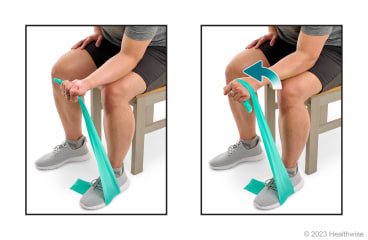
- Sit leaning forward with your legs slightly apart. Then place your affected forearm on your thigh with your hand and wrist in front of your knee.
- Grasp one end of an exercise band with your palm up. Step on the other end.
- Keeping your wrist straight, roll your palm inward as far as you can for a count of 2. Then slowly roll your palm back to the starting position to a count of 5.
- Repeat 8 to 12 times.
- It's a good idea to repeat these steps with your other arm.
Resisted forearm supination
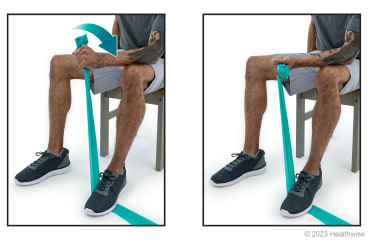
- Sit leaning forward with your legs slightly apart. Then place the forearm of your affected arm on your thigh, with your wrist in front of your knee.
- Grasp one end of an exercise band with your palm down, and step on the other end.
- Keeping your wrist straight, roll your palm outward as far as you can for a count of 2. Then slowly roll your palm back to the starting position to a count of 5.
- Repeat 8 to 12 times.
- It's a good idea to repeat these steps with your other arm.
Current as of: July 24, 2025
Author: Ignite Healthwise, LLC Staff
Clinical Review Board
All Ignite Healthwise, LLC education is reviewed by a team that includes physicians, nurses, advanced practitioners, registered dieticians, and other healthcare professionals.

